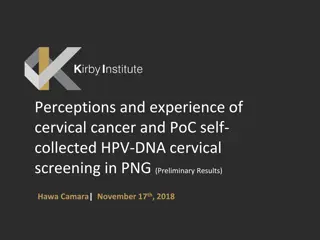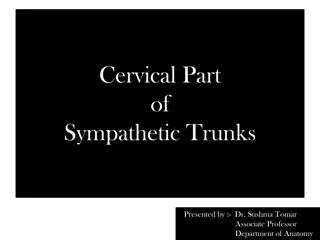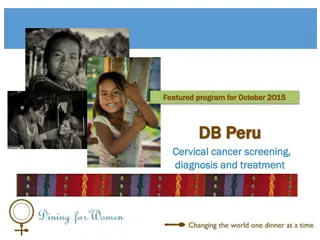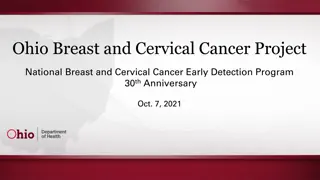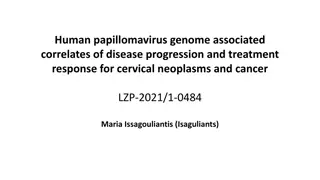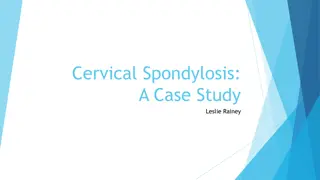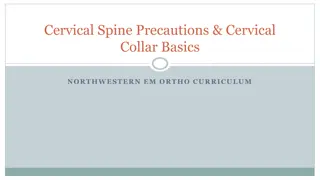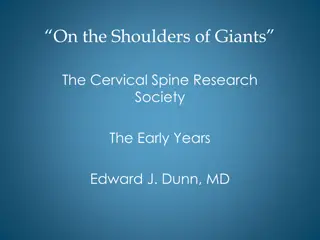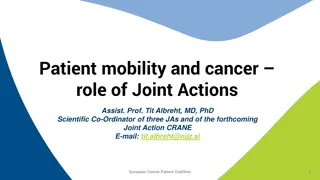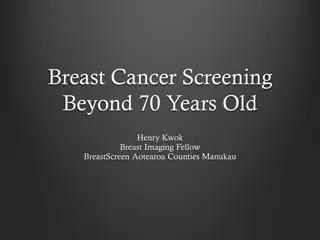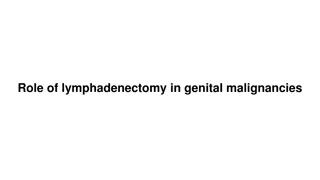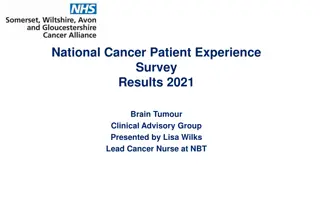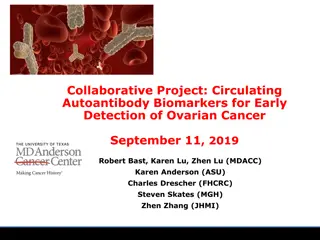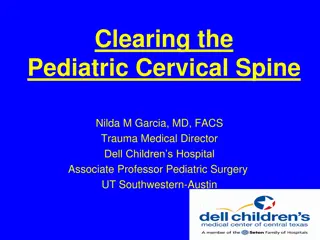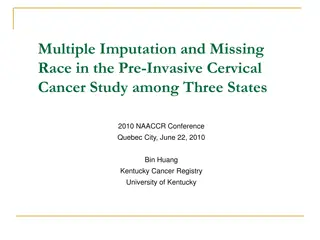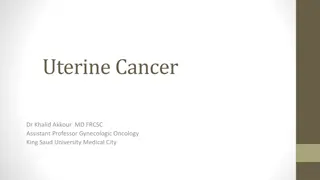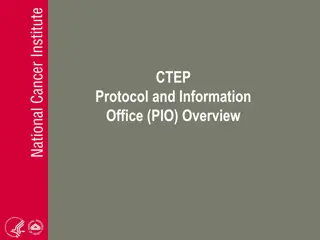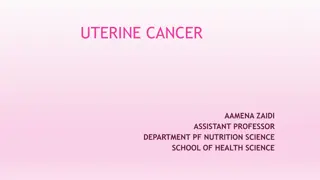Enhancing Cervical Cancer Screening through NHS Cytology Programme
The NHS Cytology Screening Programme aims to reduce incidence and mortality from cervical cancer by offering systematic, efficient screening for pre-malignant diseases. With a history dating back to 1988, the programme targets women aged 25-64, emphasizing the importance of visualizing the cervix and sampling the transformation zone. Screening every 3-5 years has led to a significant reduction in cervical cancer cases globally. Development plans for the programme include exploring liquid-based cytology, reflex HPV testing, and computer-assisted screening to enhance the quality of screening tests.
Download Presentation

Please find below an Image/Link to download the presentation.
The content on the website is provided AS IS for your information and personal use only. It may not be sold, licensed, or shared on other websites without obtaining consent from the author. Download presentation by click this link. If you encounter any issues during the download, it is possible that the publisher has removed the file from their server.
E N D
Presentation Transcript
NHS Cytology Screening Programme
Background The conventional smear has been the most successful screening test Screening every 3-5 years has reduced in 70% reduction in cervical cancer
Aims and objectives of the CPS Reduces both incidence and mortality from cervical cancer Continue to improve the programme by offering systematic, efficient screening for the diagnosis of pre-malignant disease To offer timely, appropriate investigation and treatment where indicated
Screening Incidence: -15% of all cancers in women world wide - Ranks 7thin the UK amongst cancers in women Screening - Pre-invasive phase of dysplasia (CIN) - Latent period ( CIN3 10-15y cancer) -Simple test
NHS CSP History A population based, organised (call and recall) programme was launched in 1988 at 5 yearly intervals The priorities for the first round were to improve population coverage and fail-safe follow up systems The priorities for the second round (1993-1998) were to improve the quality of programme co-ordination, smear taking and laboratory interpretation
NHS CSP Age Group 25-64 years (England) Screening interval 3 yearly up to 50 5 yearly up to 64 Outcomes Normal recall Early recall Referral Colposcopy/Oncologist
Sample Taker Must visualise the cervix Ensure the whole of the transformation zone is sampled Must record this information on the cytology request form
Transformation Zone Site where metaplastic process takes place Extends from the original squamocolumnar junction to upper limits of squamous metaplasia Area where the majority of pre-malignant conditions occur
NHS CSP Development The priorities for the third round were to maintain current achievements and to improve the quality of the screening test by considering: - Liquid based cytology - Reflex HPV testing - Computer assisted screening
Liquid based cytology A thin layer of cells is made from a representative cell sample taken from a cell suspension All cell types should be present in slide preparation
Advantages Excellent fixation Crisp cellular detail Clean background Representative cell sample Thin layer of dispersed cell over controlled area
Advantages Preparation takes less time to screen Unsatisfactory rate decreased Increased pick up rate of abnormality
Sample adequacy Representative sample from TZ, so if dyskaryotic changes are present these can be readily identified Sufficient quantity of squamous cells, but endocervical and /or metaplastic do not need to be present Ultimately the sample taker determines what is adequate sampling for the individual patient based on clinical history and visual inspection of the cervix
Unsatisfactory Samples Reasons for inadequate reports: Insufficient cellular material Obscured by polymophs Lubricant
Nature of Abnormality Negative Borderline Mild dyskaryosis Moderate dyskaryosis Severe dyskaryosis Severe dyskaryosis ? Invasive carcinoma Glandular neoplasia or ? Glandular neoplasia Inadequate
Dyskaryosis Abnormal nucleus, immature cells, thin epithelium Mild dyskaryosis CIN 1 can revert to normal Moderate and severe dyskaryosis are referred to colposcopy for further investigation
Grade of dyskaryosis Mild dyskaryosis suggests CIN 1 (abnormality confined within epithelium) Moderated dyskaryosis suggests CIN 2 (Thinner epithelium as cells not maturing/more immature cells) Severe dyskaryosis suggests CIN 3 ( immature cells, abnormal nuclei, thin epithelium)
Dyskaryosis Cytological degree of dyskaryosis should be taken to indicate the minimum degree if CIN Management should be based in degree if dyskaryosis Dyskaryotic cells which are difficult to grade should be coded and managed as moderate dyskaryosis
Slide Screening Primary Screening (8mins) Negative Abnormal Rapid review (1-2mins) Checker Confirmed negative Pathologist REPORT REPORT Maximum of 40 slides/day/screener
Report Report on sample contents Transformation zone sampled Recommendations for management
Recommendations Normal recall (3-5 yearly) Early recall ( 3,6,or 12m) Referral for colposcopy Urgent referral to Gynaecological oncologist HPV testing
HPV Triage All cervical sample with Borderline or mild dyskaryosis test results will be tested for HPV to distinguish between women who need referral to colposcopy and women who can safely be returned to routine recall Women who test positive for HPV will be referred to colposcopy Women who are HPV negative will be returned to routine recall
Test of Cure Follow up of treated CIN HPV testing will be used following treatment for CIN Women who are cytology negative and HPV negative will proceed to 3y recall avoiding the need for 10 years of annual tests Women who are cytology +ve or HPV +ve at 6months post treatment will be re- colposcoped
HPV triage outcomes Approx. 70% of BNC/Mild cases are HPV +ve Of these approx. 5% have more significant disease on histology With the Test of Cure approx. 90% are HPV -ve
Management of patient Inadequate or unsuitable -Repeat smear within 3m -3 inadequate in a row then refer to colposcopy Borderline -HPV test: - if +ve refer to colposcopy, if ve routine recall Mild dyskaryosis -HPV test : if +ve refer to colposcopy, if ve routine recall 3 abnormal results in 10 years -refer to colposcopy
Direct referral Direct referral from Cytology laboratory to Colposcopy unit Laboratory issue result to GP/Sample taker Copy sent to colposcopy Colposcopy admin book appointment for woman GP sent letter giving the details of appointment Appointment letter sent to woman from the colposcopy unit Woman has option to change appointment time
Management of patients Moderate Dyskaryosis - refer to colposcopy Severe Dyskaryosis -refer to colposcopy ? Invasive - urgent referral to gynaecologist
Management of patients Colposcopy Biopsy Treat Negative or low grade abnormal (high grade) Abnormal Follow up with cytology and possible colposcopy Negative Discharge to GP Recall as appropriate Reassess with colposcopy
Management of patients after treatment All grades of CIN, if fully removed Use of HPV testing in determining Test of Cure HPV +Ve monitored at colposcopy 6 or 12m repeat may be advised HPV negative discharged back to GP on 3 year recall If CIN is not fully removed remains under care of colposcopy team
Request form Open Exeter Loaded into GP computer system Printed as required
Cancer reform strategy Minimising the time taken to get results back to women, aiming to inform women of the results of the cervical screening test within 2 weeks of it being taken
Cytology specimen bags Readily identifiable cytology transport bags
Take home message Cervical smear is a screening test and is not 100% sensitive False negative rates of <5% are unlikely to be achieved in primary screening Regular cervical smears every 3-5 years, competently obtained and reported can prevent 80-90% of invasive cancer HPV testing will become more important in future development of the NHS CSP


